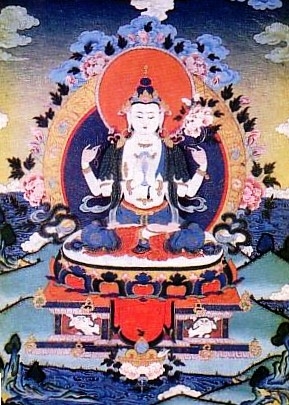Bodhichitta

Bodhichitta (Skt. bodhicitta; Tib. chang chub kyi sem; Wyl. byang chub kyi sems) - The compassionate wish to attain enlightenment for the benefit of all beings.
Definition
Bodhi means our ‘enlightened essence’ and chitta means ‘heart’ or 'mind', hence the translation ‘the heart of enlightened mind’.
The most famous definition of bodhichitta appears in Maitreya's Abhisamayalankara:
- Arousing bodhichitta is: for the sake of others,
- Longing to attain complete enlightenment.
- sems bskyed pa ni gzhan don phyir//Tib. སེམས་བསྐྱེད་པ་ནི་གཞན་དོན་ཕྱིར༎
- yang dag rdzogs pa'i byang chub 'dod//Tib. ཡང་དག་རྫོགས་པའི་བྱང་ཆུབ་འདོད༎
This has twin aspects or purposes: 1) focusing on sentient beings with compassion, and 2) focusing on complete enlightenment with wisdom.
Divisions
Bodhichitta is categorized into ‘relative’ or ‘conventional bodhichitta’, and ‘absolute bodhichitta’.
- Relative bodhichitta entails the compassionate wish to attain enlightenment for the benefit of all living beings and to train in the methods to achieve that aim. In relative bodhichitta there is also the distinction between ‘bodhichitta in aspiration’ and ‘bodhichitta in action’, which is portrayed by Shantideva as the difference between deciding to go somewhere and actually making the journey.
- Absolute bodhichitta is the direct insight into the absolute nature of things.
The Three Types of Commitment
- the king's way of arousing bodhichitta, with the great wish
- the boatman's way of arousing bodhichitta, with sacred wisdom
- the shepherd's way of arousing bodhichitta, beyond compare
Four Types of Bodhichitta According to the Paths and Levels
- bodhichitta of aspiring conduct (path of accumulation onwards)
- bodhichitta of pure noble intention (first bhumi onwards)
- bodhichitta of full maturation (eighth bhumi onwards)
- bodhichitta free from all obscurations (at the level of buddhahood)
There is also a division into twenty-two similes of bodhichitta, and the Sagaramatiparipriccha Sutra (blo gros rgya mtshos zhus pa'i mdo) mentions a classification according to eighty inexhaustibles which are discussed in Mipham Rinpoche's Khenjuk.
The Actual Training in Bodhichitta
Patrul Rinpoche says that the training in bodhichitta has three elements:
- training in the cause by meditating on the four immeasurables,
- the actual training, which is to practise taking the vow of bodhichitta three times during the day and three times at night,
- and the training in the precepts, the meditations on equalizing and exchanging yourself and others, and consider others as more important than yourself.
The actual training in bodhichitta is to take the vow of bodhichitta by means of any formal practice—whether elaborate, medium or short—at the six times of the day and night, i.e., at dawn, mid-morning, midday, afternoon, dusk and midnight.
- 'Equalizing self and others’ means recognizing the equality of yourself and others in wishing to find happiness and wishing to avoid suffering.
- ‘Exchanging self and others’ means giving your own happiness to other sentient beings, and taking their suffering upon yourself.
- ‘Considering others as more important than yourself’ means setting aside your own benefit and accomplishing the benefit of others.
If you apply yourself to these practices, Patrul Rinpoche says, then you will never forget the mind of bodhichitta in all your future lives, and all the qualities of the bhumis and paths will develop and increase like the waxing moon.
Bodhichitta in Dzogchen
In a Dzogchen context, especially in the teachings of the category of mind, bodhichitta is used to refer to the awakened mind, or rigpa. In Chapter 12 of the Treasury of the Dharmadhatu, Longchenpa explains the literal meaning of bodhichitta in Dzogchen:
- Within the broad expanse, the ground of naturally arising wisdom,
- There has never been any flaw, and so, untainted by samsara, it is pure (chang).
- Enlightened qualities are present spontaneously, and therefore, beyond cause and effect, it is consummate (chub).
- In essence it is self-aware pure luminosity, and therefore it is mind (sem)—
- Within this bodhichitta, the awakened mind, utterly pure, all is contained.
This is his commentary on the verse:
- "Within the essence of rigpa, there has never been any flaw and so, since there has never been any experience of samsara, it is pure (chang). Within that very essence, enlightened qualities are spontaneously present, and so it is consummate (chub) and can arise as anything at all. It is mind (sem) because its compassionate responsiveness is all-pervasive and extends throughout all samsara and nirvana, and it is clear light; and because it arises as our own individual self-knowing rigpa."